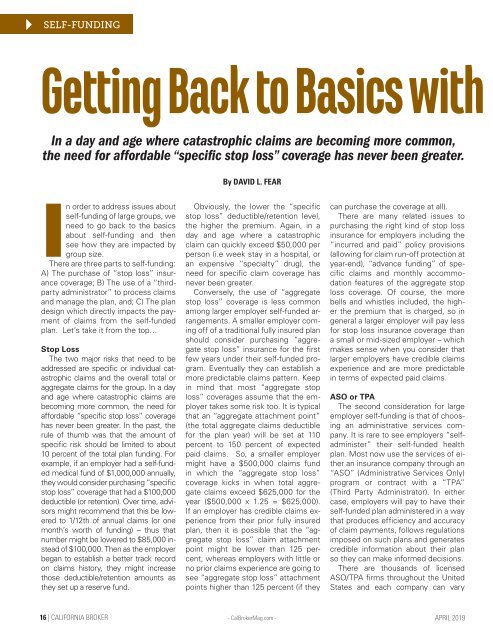California Broker April 2019
You also want an ePaper? Increase the reach of your titles
YUMPU automatically turns print PDFs into web optimized ePapers that Google loves.
GUEST SELF-FUNDING EDITORIAL<br />
In a day and age where catastrophic claims are becoming more common,<br />
the need for affordable “specific stop loss” coverage has never been greater.<br />
By DAVID L. FEAR<br />
In order to address issues about<br />
self-funding of large groups, we<br />
need to go back to the basics<br />
about self-funding and then<br />
see how they are impacted by<br />
group size.<br />
There are three parts to self-funding:<br />
A) The purchase of “stop loss” insurance<br />
coverage; B) The use of a “thirdparty<br />
administrator” to process claims<br />
and manage the plan, and; C) The plan<br />
design which directly impacts the payment<br />
of claims from the self-funded<br />
plan. Let’s take it from the top…<br />
Stop Loss<br />
The two major risks that need to be<br />
addressed are specific or individual catastrophic<br />
claims and the overall total or<br />
aggregate claims for the group. In a day<br />
and age where catastrophic claims are<br />
becoming more common, the need for<br />
affordable “specific stop loss” coverage<br />
has never been greater. In the past, the<br />
rule of thumb was that the amount of<br />
specific risk should be limited to about<br />
10 percent of the total plan funding. For<br />
example, if an employer had a self-funded<br />
medical fund of $1,000,000 annually,<br />
they would consider purchasing “specific<br />
stop loss” coverage that had a $100,000<br />
deductible (or retention). Over time, advisors<br />
might recommend that this be lowered<br />
to 1/12th of annual claims (or one<br />
month’s worth of funding) – thus that<br />
number might be lowered to $85,000 instead<br />
of $100,000. Then as the employer<br />
began to establish a better track record<br />
on claims history, they might increase<br />
those deductible/retention amounts as<br />
they set up a reserve fund.<br />
Obviously, the lower the “specific<br />
stop loss” deductible/retention level,<br />
the higher the premium. Again, in a<br />
day and age where a catastrophic<br />
claim can quickly exceed $50,000 per<br />
person (i.e week stay in a hospital, or<br />
an expensive “specialty” drug), the<br />
need for specific claim coverage has<br />
never been greater.<br />
Conversely, the use of “aggregate<br />
stop loss” coverage is less common<br />
among larger employer self-funded arrangements.<br />
A smaller employer coming<br />
off of a traditional fully insured plan<br />
should consider purchasing “aggregate<br />
stop loss” insurance for the first<br />
few years under their self-funded program.<br />
Eventually they can establish a<br />
more predictable claims pattern. Keep<br />
in mind that most “aggregate stop<br />
loss” coverages assume that the employer<br />
takes some risk too. It is typical<br />
that an “aggregate attachment point”<br />
(the total aggregate claims deductible<br />
for the plan year) will be set at 110<br />
percent to 150 percent of expected<br />
paid claims. So, a smaller employer<br />
might have a $500,000 claims fund<br />
in which the “aggregate stop loss”<br />
coverage kicks in when total aggregate<br />
claims exceed $625,000 for the<br />
year ($500,000 x 1.25 = $625,000).<br />
If an employer has credible claims experience<br />
from their prior fully insured<br />
plan, then it is possible that the “aggregate<br />
stop loss” claim attachment<br />
point might be lower than 125 percent,<br />
whereas employers with little or<br />
no prior claims experience are going to<br />
see “aggregate stop loss” attachment<br />
points higher than 125 percent (if they<br />
can purchase the coverage at all).<br />
There are many related issues to<br />
purchasing the right kind of stop loss<br />
insurance for employers including the<br />
“incurred and paid” policy provisions<br />
(allowing for claim run-off protection at<br />
year-end), “advance funding” of specific<br />
claims and monthly accommodation<br />
features of the aggregate stop<br />
loss coverage. Of course, the more<br />
bells and whistles included, the higher<br />
the premium that is charged, so in<br />
general a larger employer will pay less<br />
for stop loss insurance coverage than<br />
a small or mid-sized employer – which<br />
makes sense when you consider that<br />
larger employers have credible claims<br />
experience and are more predictable<br />
in terms of expected paid claims.<br />
ASO or TPA<br />
The second consideration for large<br />
employer self-funding is that of choosing<br />
an administrative services company.<br />
It is rare to see employers “selfadminister”<br />
their self-funded health<br />
plan. Most now use the services of either<br />
an insurance company through an<br />
“ASO” (Administrative Services Only)<br />
program or contract with a “TPA”<br />
(Third Party Administrator). In either<br />
case, employers will pay to have their<br />
self-funded plan administered in a way<br />
that produces efficiency and accuracy<br />
of claim payments, follows regulations<br />
imposed on such plans and generates<br />
credible information about their plan<br />
so they can make informed decisions.<br />
There are thousands of licensed<br />
ASO/TPA firms throughout the United<br />
States and each company can vary<br />
16 | CALIFORNIA BROKER - Cal<strong>Broker</strong>Mag.com -<br />
APRIL <strong>2019</strong>

















